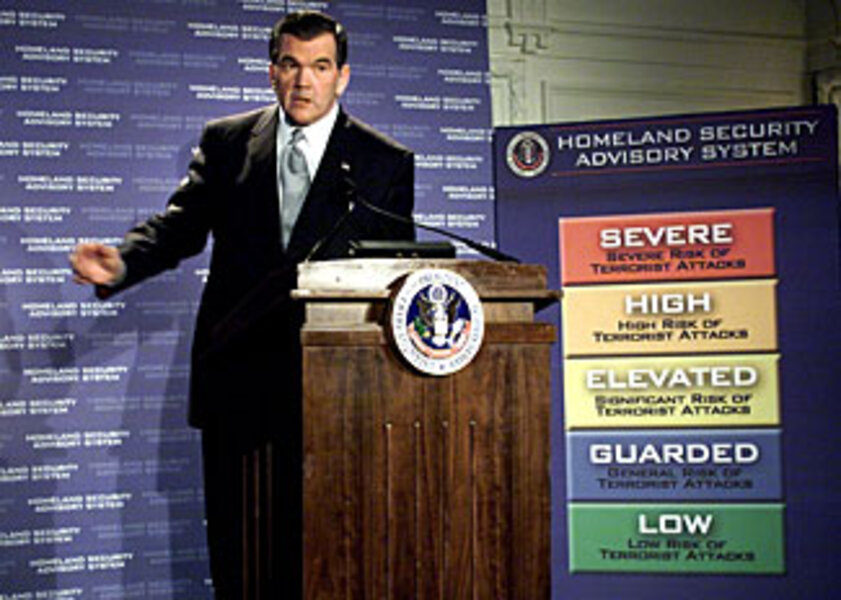Ridge's book raises pressure to reform color-coded 'threat alerts'
Loading...
| Washington
The suggestion that politics influenced the Department of Homeland Security's color-coded terror alert system doesn't necessarily mean that a task force will conclude next month that it should be scrapped altogether.
A new book by former Homeland Security Chief Tom Ridge says he felt political pressure by the Bush administration prior to the election in 2004 to raise the threat level from "yellow" to "orange," raising suspicions that the terror alert system created after 9/11 was more political than functional.
The system has always been problematic, in part because of the confusing messages the color codes sent. If one day is yellow and another day is orange, what should the average American do any differently? The answer is, few people knew.
But a task force due to make final recommendations to current Homeland Security Chief Janet Napolitano Sept. 14 may be more likely to overhaul it than jettison it. While Mr. Ridge didn't say the system was broken, his revelation suggests the system is open to abuse, and that is a key take-away as task force members prepare to make final recommendations.
(Bush administration officials, including former Defense Secretary Donald Rumsfeld, deny the assertion that Ridge was pressured to raise the threat level for political reasons.)
Task force members would not talk about the two formal meetings they've had as a group so far. But some believe the system should not be designed as a terrorist alert system for the public as much as an internal system to be used by authorities with specific direction. The current system makes no such distinction, so first responders such as police and fire departments are essentially given the same vague notice as the public.
"I've always said the fundamental problem is this system was never designed to be a terrorist alert system for the public," says James Carafano, a senior research fellow at the Heritage Foundation, a conservative think tank in Washington, and a member of the task force. "But from day one, this is how the public perceived it, as a national alert."
The public credibility in this system has been tainted already, driving arguments that it should be significantly changed. "Perception is reality, and you have to deal with it; fundamentally, that is the challenge they face," he says.
To the extent the public is even aware of the five-color system, the code remains somewhat baffling. The bottom wrung is green for low risk, blue for "guarded" risk, yellow for "elevated," orange for "high," and red for "severe."
The system's most frequent color is yellow, and DHS has never designated the threat lower than yellow, according to DHS officials. It has been raised from yellow to orange several times, including in August 2004, the time Ridge suggested it was raised for political purposes prior to the election. It was raised to red only once, and only for flights originating in the United Kingdom following a terrorist threat there.
On Friday, the national threat advisory was yellow-elevated, meaning there is "significant risk of terrorist attack." But nowhere on the Homeland Security's website are there clear definitions of what the different colors mean, let alone what Americans should do differently on any given day.
"That kind of lack of specificity is the primary critique from the public that the task force has gotten during their review," says Sean Smith, a spokesman for DHS.
Both Ridge and Michael Chertoff, who replaced Ridge as homeland security chief, have met with the DHS task force, says Mr. Smith.
----
Follow us on Twitter.





